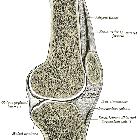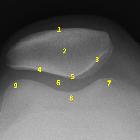Patella




The patella (plural: patellae) is the largest sesamoid bone in the human body. It lies within the quadriceps tendon/patellar tendon and forms part of the knee joint and extensor mechanism of the knee .
Gross anatomy
Osteology
The patella is triangular in shape with a superior base and inferior apex. The proximal three-quarters of the posterior surface is smooth, composed of articular cartilage, which is the thickest in the body, as much as 5 mm in some adults. The distal pole of the posterior surface of the patella does not functionally form part of the joint and is denuded of cartilage . The posterior surface is divided into medial and lateral facets by a vertical ridge. The medial most portion of the medial facet lacks articular cartilage and is known as the odd facet .
The anterior surface is rough, for attachment of tendons and ligaments.
The ossification centers of the patella appear between 3 and 6 years. They fuse at puberty, with higher levels of physical activity.
Articulations
The medial and lateral facets of the patella are covered in hyaline cartilage and articulate with the medial and lateral condyles of the femur, respectively, to form the patellofemoral component of the knee joint. Some authors describe the medial facet as having superior, middle, inferior and lateral portions and the lateral facet as having superior, middle and inferior portions (subfacets) . The lateral facet is larger than the medial, which allows for side identification when the bone is placed posterior surface down on a flat surface .
Attachments
Musculotendinous and ligamentous
The patella serves for attachment of the quadriceps tendon (superiorly) and the patellar tendon (which attaches to the tibial tubercle, inferiorly), although few quadriceps tendon fibers are continuous over the anterior surface. The quadriceps tendon and patellar tendon are really the same structure with the patella (as a sesamoid bone) embedded within it.
The medial and lateral patellar retinaculum, which are condensations of fascia rather than true ligaments, attach the patella margins to surrounding fascia. The medial patellar retinaculum attaches to the vastus medialis / sartorius fascia and is often disrupted in lateral patellar dislocation. The lateral patellar retinaculum is attached to the fascia of vastus lateralis and iliotibial band .
The quadriceps muscles pull the patella obliquely and laterally in relation to the femur. There are factors that prevent such displacement: larger lateral condyle of the femur, tension in the medial retinacular fibers and direction of insertion of fibers of the vastus medialis muscle.
The medial patellofemoral ligament (MPFL) originates near adductor tubercle of the femur and inserts into the superomedial aspect of the patella. Its function is to prevent lateral patellar dislocation during knee extension.
Relations
- superior: quadriceps tendon, suprapatellar bursa
- inferior: patellar tendon, infrapatellar bursa, infrapatellar fat pad
- lateral: lateral patellar retinaculum
- medial: medial patellar retinaculum
- posterior: knee joint, femur
- anterior: prepatellar bursa
Arterial supply
Arterial blood enters via the anterior surface of the patella and an anastomotic patella ring is formed supplied by the paired superior and inferior geniculate arteries as well as the anterior tibial recurrent artery .
Venous drainage
In general the draining veins are the counterparts to the aforementioned arteries.
In addition there is a complementary system of veins running deep to the articular cartilage forming a subarticular drainage network .
Innervation
- branches of nerves to vastus medialis and vastus lateralis
Variant anatomy
- bipartite patella
- multipartite patella
- absent patella
- variation in shape (see: Wiberg classification)
- dorsal defect of the patella (may occasionally be symptomatic)
Related pathology
- patella fracture
- lateral patellar dislocation
- patellar instability
- patella baja
- patella alta
- chondromalacia patellae
- nail-patella syndrome
- patella sleeve syndrome
- patellar tendon rupture
- patellar tumor
Siehe auch:
- Chondromalacia patellae
- Patella bipartita
- Patella alta
- Patellafraktur
- Patella baja
- Patella multipartita
- Patellaaplasie
- Nagel-Patella-Syndrom
und weiter:

 Assoziationen und Differentialdiagnosen zu Patella:
Assoziationen und Differentialdiagnosen zu Patella:





